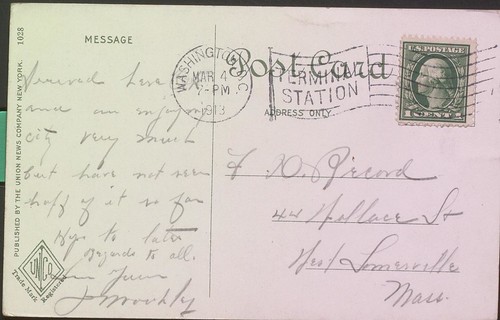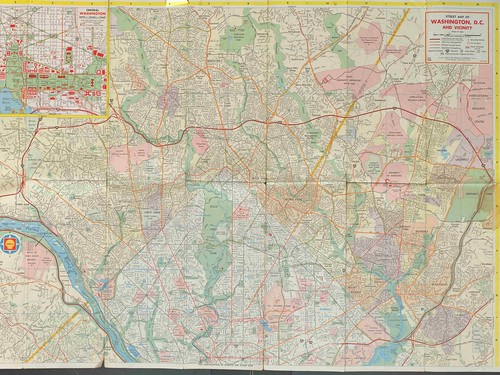Postcard exhibit at DC Chapter of American Institute of Architects
The Post columnist John Kelly writes about the current postcard exhibit at the DC chapter of the American Institute of Architects, Wish You Were Here! Vintage Postcards from Washington, D.C. which is up through Friday September 8th ("Postcards from paradise — or at least from Washington, D.C.").
On Thursday August 31st, there will be a talk, "Greetings from Hometown Washington, DC," about the exhibit, by Jerry McCoy, a DCPL librarian, avid postcard collector, and chair of the Silver Spring Historical Society.
The exhibit is cool and worth looking at. One neat element is that the exhibit includes items from a number of DC institutions and private collectors.
I saw a bunch of postcards I hadn't seen before--but I found it somewhat disappointing because while the didactics discuss how postcards were used to send messages and communicate, no backs of postcards/no messages are displayed.
In their own right, backs of postcards are also interesting in how the printed text communicates about the value of what is displayed on the front.
Backs of the postcards may include text and logos from "sponsors" be it a local motel or a railroad line, which made postcards available on signature passenger trains.
Besides the great images depicted on the fronts of postcards, I like postcards because of the text of the message, where people describe their impressions of the city, what they did and where they visited, etc.
When I picked up this card in Seattle (left), because the front is nondescript (a 1960s era card), my partner asked me why I bothered. I said, read it.
The writer-sender described being in the city to attend a conference and the inconveniences posed by there being a massive anti-war demonstration at the same time.
Finally, backs of postcards can be interesting because of the postmarks. Some individual post offices cancelled their own mail. I have postmarked cards from Brookland, Takoma Park, and Union Station in DC, and Ballston, in Arlington County. (I might have one from Silver Spring, Maryland too.)
It would have been interesting to show such cards also--Georgetown had its own cancellation pre-1900, but I haven't been able to find one after that time frame. But I keep looking...
This postcard back (an image from the Internet, not in my possession) shows both this kind of message as well as a localized postmark from "Terminal (Union) Station."

In terms of the mounting of the exhibit as pointed out in the Kelly column, part of the show is displayed behind a table under the stairs making it extremely difficult to view the postcards shown in that section of the exhibit. Although it is nice that each original card was scanned and is shown at a size larger than real life.
For people interested in postcards and urbanism, the great book by Alison Isenberg, Downtown America: a history of the place and the people who made it (commentary), which analyzes the impact of the Depression on downtowns and the real estate industry, uses the postcard archives of the former Curt Teich Company to illustrate and discuss how communities portrayed and marketed themselves.
Finally, one of the great things about collecting postcards of "Washington" is that because of people visiting here and communicating with people "back home," you can find great Washington ephemera all over the country.
E.g., a Shell gas station road map of DC dated 1966 that I picked up in Richmond shows the then proposed freeway routes that were successfully fought off later in response to a citizen campaign against the freeways.

Labels: local history, urban history





0 Comments:
Post a Comment
<< Home